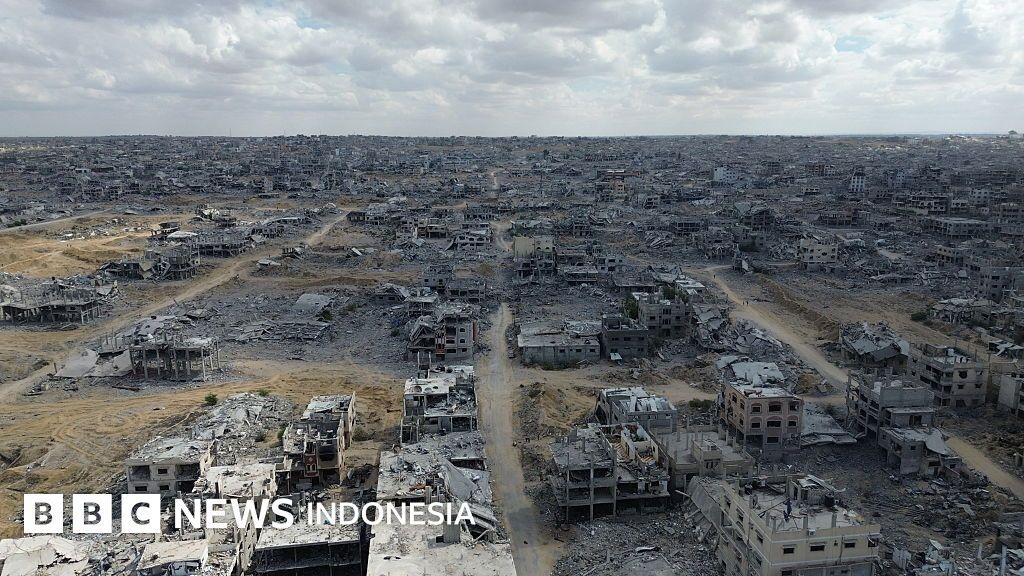Rebuilding homes, businesses and all the infrastructure that supports life in Gaza is no easy task.The United Nations estimates losses at about $70 billion.According to Andreas Krieg, an expert on Middle East security at King's College London, conditions on the ground are "worse than they were to begin with."
What is the role of returning to Gaza?- "worse than starting from scratch"
- Author, Paul Brown
- Author, Kyle Devlin.
- Author, Erwan Rivault
- Tusitala, Barbara Mezerler
- role, confirmation
When thousands of Gazans returned to their neighborhoods after the ceasefire was announced, some of them found their homes empty and empty.
Rebuilding all the homes, businesses and infrastructure to support life in Gaza is no easy task.The United Nations estimates the damage at around $70 billion.
According to Andreas Krieg, a Middle East security expert at King's College London, conditions on the ground are "worse than they were at the beginning."
"Because [development] here doesn't start from sand," said Andreas Krieg, adding, "but from rubble."
The severity of the destruction in the Gaza strip is now "in the range of 84%, and in some areas, such as Gaza City, it has now been represented by Palamine for Palestine.
Damage of that magnitude created piles of rubble of sizes hard to imagine.
According to the analysis of the latest satellite images, confirm the estimate that there are more than 60 million tons waiting to be cleared to Gaza.
But any effort to rebuild the region must start with the most basic thing: cleaning up the remnants of war.
In-depth coverage of Indonesian news live on WhatsApp.
Click here
The end of WhatsApp
The millions of tons of rubble now covering the Gaza Strip are more than just cracked concrete and bent metal.Human remains and unexploded bombs are still buried under the rubble.
"From a security and humanitarian point of view, the first step is to secure the damaged area," said former JCB boss Philippe Bouvera.
After that, a long process awaits: sorting, separating and then destroying the waste.Materials such as plastic and steel will be taken, while the remaining concrete will be crushed so it can be reused.
The department will provide the basis for the creation of new projects, but its implementation requires a great outlay of building materials.
Bouverat continues, "The goal of this major effort is to rely solely on trucks crossing the border."
"The first step is to build a deep sea port so thousands of containers can enter Gaza."
Once damaged areas are cleared, essential services such as clean water, sanitation and electricity are restored.
Water and Sewerage
At this time, clean water is an urgent need for the residents of Gaza
According to UNICEF, at least 70 percent of the 600 water and sanitation facilities in the region have been damaged or destroyed since October 7, 2023.
After the announcement of the ceasefire, Israeli soldiers are shown in front of a burning waste processing plant in Gaza City.
The loss occurred shortly before Israeli forces withdrew from positions near the facility.
Recycling is very important to prevent the accumulation of dirt and the spread of disease.
Doctors report an increase in deadly diarrhea diseases in childhood and a risk of cholera in some areas.
Satellite images show the destruction of the Bioch Biological Tower, an important facility for processing waste in Gaza.
According to Coastal Municipal Water Works (CMWU) Deputy Director Maher Nazar, all six water treatment plants in Gaza are currently in a state of damage.
Repair efforts were severely hampered by Israeli air and artillery attacks and equipment shortages.Some facilities were even attacked again after being repaired.
The IDF said its actions were "based on military needs and according to international law," to prevent Hamas from threatening Israeli cities.
In addition to waste processing, pure water supply facilities are also seriously damaged.
Satellite images from April 2024 show a seawater desalination plant in northern Gaza still intact, but the plant was destroyed in early May.
"We are talking about damaged wells, destroyed networks and reservoirs, broken water pipes. It is very difficult to determine where to start. To restore about 20% of services, we need at least $50 million," Najjar said.
"Total damages could be $1 billion or more."
Satellite images show breathtaking scenes in the Sheikh Rizwan area, northeast of Gaza City.
Last August, before Israeli forces took control of what they called "Hamas' last stronghold," roads in the area still appeared intact.
On the contrary, the settlement blocks have now been destroyed after being used as a military base for the Israel Defense Forces.
According to Usotot, a satellite observatory, a total of 282,904 houses in Gaza were damaged or destroyed.
However, this figure does not consider the situation on the ground, because it does not include the impact of recent military operations in Gaza City.
In the middle of 2024, the main damage has been done to a great extent, which corresponds to the massive work of the Israelis.The same is expected during the occupation of Gaza City.
The government of Hamas-controlled Gaza City said 90 percent of the city's roads were destroyed and damaged.
Shirley Culbertson, a senior fellow at the RAND Corporation, said it could take decades to rebuild homes in Gaza.
Shelly said: "After the Israeli bombings in 2014 and 2021, the reconstruction slowed down because Israel limited the import of construction materials that it believed could be misused.
"If there is a similar method, this process could last 80 years. If there is good organization, time could continue," continued the example of designing a camp that could develop in a permanent place.
Even before the war, Gaza's electrical system was fragile.Constant power outages have become commonplace, and most residents prefer electricity for only a few hours a day.
Most of the electricity will come from the grid to power plants in Israel and Gaza, powered by diesel fuel and solar panels on rooftops and public buildings.
However, after Israel cut off electricity to Gaza on October 11, 2023, there was a complete blackout.
The only exception is a direct line to a desalination plant in southern Gaza, which was on and off several times until March 2025.
The main power plant was out of order due to lack of fuel and many solar panels were damaged.
According to a joint report by the World Bank, the European Union and the United Nations, more than 80% of electricity generation and distribution assets have been destroyed or inactivated, with losses exceeding $494 million.
Shared power company GEDCO said 70% of its buildings and facilities were destroyed as of October 2023.
Last month, a verified video showed that the headquarters of GEDCO was hit.
The company said the attack "directly disrupted the company's ability to perform technical and administrative functions."
Jahiliya East satellite east of 4 sq.km.
In the middle of the plain you can see the road built by the IDF to access the northern area of Gaza City.
University director university director, that's it, 82.4% of the forest is a lot of war.
The lack of popularity of agriculture, combined with aid restrictions, has led to a severe food crisis, which was underestimated in the declaration of weakness in Gaza City in September.
Unoset, it is about the decline since "they act like a landlord, they use heavy vehicles."
Boverat said the land must be immediately cleared of unexploded bombs, bullets and landmines to get agriculture back on track.
"If they can plant more, they can eat their produce. Soon," he said.
Before the war, almost half of Gaza's population was under the age of 18.As a result, rebuilding schools is the key to restoring normal life.
During the war, the school building sheltered displaced residents, but it was also frequently targeted by the IDF, which accused the facility of being used as a center for Hamas operations.
The United Nations High Commissioner for Refugees (UNRWA), which previously operated 288 schools in Gaza, reported that 91.8% of school buildings "require complete reconstruction or major repairs to return to use".
Not even the universities were spared from destruction.
In December 2023, Israeli forces destroyed al-Azhar University south of Gaza City.The site is now part of the Netzarim Corridor, one of the military zones established by the IDF during the war.
A similar fate happened to Beyfell Beyfell Beyfell was destroyed two kilometers away, even after it was temporarily used as a base by Israeli forces.








